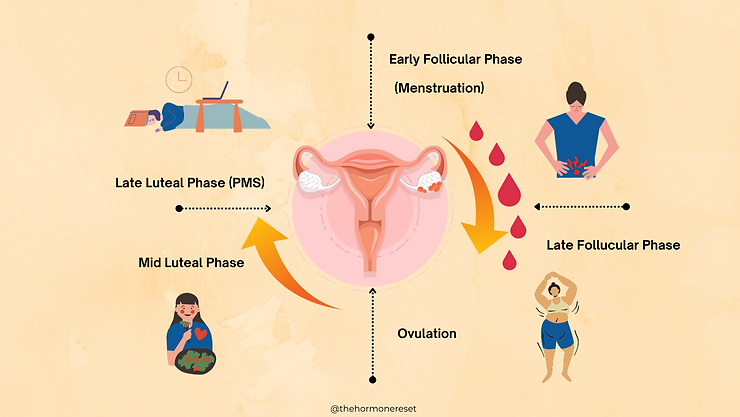Cycle syncing is an all-encompassing method of managing your menstrual cycle that entails coordinating your lifestyle, physical activity, and diet with the different phases of your cycle.
This enhances both your physical and emotional well-being and your performance.
The menstrual cycle has four phases: menstruation, the follicular phase, ovulation, and the luteal phase. Each phase is connected to specific hormonal and physiological alterations in a woman’s body that may impact different facets of her physical and emotional wellbeing. Women can enhance their general well-being by understanding these changes and adjusting to them.
Cycle synchronisation advantages
Cycle synchronisation can benefit women in a variety of ways, including:
- Possibility of fewer menstrual symptoms like mood swings, bloating, and cramps
- Make your exercise regimen more efficient and effective.
- Optimum energy management is achieved by timing activities to coincide with hormonal changes that occur naturally
- Enhancing focus and productivity by taking advantage of times of increased energy and mental clarity
- Potential control of hormonal balance and menstrual cycles over time
- Live in harmony with your body.
- Describe the best time to conceive and offer fertility support.
- Greater sense of control over one’s body and connection to it
- Potential improvement in sleep quality and stress management
- Potential improvement in overall well-being and quality of life.

Let us quickly review the menstrual cycle’s various phases!
- Menstruation: is the first phase of the menstrual cycle, which begins on the first day of bleeding. During menstruation, the uterus sheds its lining, causing the vagina to leak blood and tissue. Hormone levels, especially estrogen and progesterone, are relatively low during this phase, which may cause fatigue and bloating.
- Follicular Phase: The follicular phase begins immediately after menstruation and lasts until ovulation. During this stage, the pituitary gland secretes follicle-stimulating hormone (FSH), which stimulates ovarian follicle growth and maturation. These follicles contain eggs and produce estrogen as they grow. Estrogen is essential for thickening the uterine lining and preparing it for pregnancy. During this phase, estrogen levels are increasing gradually, which can improve your mood and energy levels.
- Ovulation: Ovulation typically happens 14 days before the start of the subsequent period, in the middle of the menstrual cycle. The dominant follicle bursts during ovulation, releasing a mature egg from the ovary. An increase in luteinizing hormone (LH) produced by the pituitary gland initiates this process. Just before ovulation, estrogen levels reach their peak, encouraging egg release and raising cervical mucus to allow sperm movement.
Your mood, energy level, and libido can all improve because estrogen and progesterone levels are at their highest during this phase.
- Luteal Phase: The luteal phase begins after ovulation and lasts until the following period. The ovary’s ruptured follicle develops into the corpus luteum after the egg has been released from it. Progesterone, which is produced by the corpus luteum, helps to maintain and thicken the uterine lining in preparation for the implantation of a fertilized egg. In the absence of fertilization, estrogen and progesterone levels drop, causing the uterine lining to shed and a new menstrual cycle to begin. Your progesterone levels rise during this stage, which may result in symptoms including bloating, breast soreness, and mood swings.
How do you cycle in sync with the first phase (the menstrual phase) of your menstrual cycle?
During the menstrual phase, hormone levels, particularly estrogen and progesterone, are relatively low, which can lead to feelings of fatigue and bloating. So, it’s important that you choose your food and physical activities accordingly.
Foods to eat during the menstrual phase
- Iron-Rich Foods: Because menstruation involves blood loss, it is critical to replenish iron levels. Include iron-rich foods in your diet, such as leafy greens, legumes and lean meats (if you are a non-vegetarian)
- Anti-inflammatory Foods: Some women experience cramps and inflammation during their menstrual cycle. Consume anti-inflammatory foods such as fatty fish (salmon, mackerel), turmeric, ginger, and green leafy vegetables.
- Hydration is critical throughout your cycle, including during menstruation. Drink plenty of structured water and eat hydrating fruits and vegetables.
Add this to your shopping list for the menstrual phase:
- Green leafy vegetables
- Pumpkin seeds
- Millets
- Lean meat
- Lentils
- Fatty fish
- Eggs
- Nuts
- Turmeric
- Ginger
Exercise cycle syncing guidelines during the menstrual phase
- Gentle yoga or stretching: These activities can help relieve cramps and promote relaxation.
- Meditation or mindfulness practices: Engaging in calming mental exercises can aid in stress reduction and emotional well-being.
- Light aerobic exercises: Low-impact activities such as walking or gentle cycling can help improve circulation and mood.

How do you sync your cycle with the second phase (Follicular phase) of your menstrual cycle?
During the follicular phase, estrogen levels are gradually increasing, which can improve your mood and energy levels.
Foods to eat during the luteal phase
Follicular phase
- Balanced Nutrition: Eat a well-rounded, nutrient-dense diet rich in fruits, vegetables, whole grains, lean proteins, and healthy fats. Your body will receive the nutrients it needs for optimum hormone production as a results
- Foods High in Phytoestrogen: Plant compounds called phytoestrogens act as the body’s estrogen substitute. Phytoestrogen-rich foods like flaxseeds, soy products (only non-GMO varieties are recommended), lentils, and chickpeas may support hormone balance during this phase.
- Foods High in Fiber: Consuming a diet rich in fiber can promote healthy digestion and assist in maintaining stable blood sugar levels. Whole grains, legumes, fruits, and vegetables are high in dietary fiber.
Your shopping list should include the following foods for the follicular phase:
- Green, leafy vegetables
- Flaxseeds and pumpkin seeds
- Avocado
- Broccoli
- Nuts/seed mix
- Olive oil
- Zucchini
- Fish
- Protein sources
Exercise cycle syncing guidelines during the follicular phase
- Energy-Boosting Activities: With rising estrogen levels, you may experience increased energy during the follicular phase. Utilize this by engaging in high-intensity activities like cardio, weightlifting, or HIIT (High-Intensity Interval Training)
- Try Out New Exercises: The follicular phase is linked to an excitement for discovery and novelty. It is a great opportunity to try out any new hobbies or fitness classes you have been thinking about. This can inspire you to stay active and keep your workouts interesting
- Focus on Endurance and Stamina: Your endurance and stamina may improve at this point. Make the most of this time by challenging yourself with longer workouts or by gradually raising the level of your workout intensity.

How do you sync your cycle with the third phase (Ovulatory phase) of your menstrual cycle?
Estrogen and progesterone are at their highest levels at this time, and the body is ready for conception. Here are some suggestions for coordinating your diet and exercise program with the third phase:
Foods to eat during the Ovulatory phase
- Balanced Macronutrients: Eat a well-balanced diet that includes carbohydrates, proteins, and healthy fats. This will give your body the energy and nutrients it needs to produce hormones optimally.
- Omega-3 Fatty Acids: Consume omega-3 fatty acid-rich foods such as fatty fish (salmon, mackerel, and sardines), chia seeds, flaxseeds, and walnuts. Omega-3 fatty acids are anti-inflammatory and may aid in hormonal balance.
- Antioxidant-Rich Foods: Eat antioxidant-rich foods such as berries, dark leafy greens, colorful vegetables, and green tea. During this stage, antioxidants can help reduce oxidative stress and support overall health.
Add these food items to your shopping list for the ovulatory phase:
- Whole grains
- Eggs
- Leafy green vegetables
- Tomatoes
- Flaxseeds and pumpkin seeds
- Fruits: Berries, citrus fruits, papaya
Exercise cycle syncing guidelines during the ovulatory phase
- High-Intensity Workouts: During the ovulatory phase, when estrogen and progesterone levels are at their highest, you may have more energy and endurance. Use this to your advantage by incorporating high-intensity workouts such as interval training, running, or cycling.
- Resistance Training and Strength Exercises: Resistance training and strength exercises can be beneficial during this phase. They aid in the enhancement of muscle tone, strength, and bone health. Consider incorporating weightlifting, bodyweight exercises, or resistance bands.
- Social and team activities: The ovulatory phase is frequently associated with increased sociability and confidence. Consider participating in group exercises or team sports that promote social interaction and a sense of camaraderie.

How do you cycle sync during the fourth phase (luteal phase) of your menstrual cycle?
During this phase, progesterone levels rise, and the body prepares for either pregnancy or the start of a new menstrual cycle. Premenstrual syndrome, or PMS, may occur.
Foods to eat during the luteal phase
- Balanced Nutrition: Focus on consuming a well-balanced diet that includes a variety of fruits, vegetables, whole grains, lean proteins, and healthy fats. Aim for nutrient-dense foods to support overall health.
- Complex Carbohydrates: Include complex carbohydrates such as whole grains, legumes, and starchy vegetables in your meals. These foods provide sustained energy and can help stabilize blood sugar levels.
- Healthy Fats: Incorporate healthy fats from sources like avocados, nuts, seeds, and olive oil. Healthy fats can help with satiety, hormone production, and absorption of fat-soluble vitamins.
Exercise cycle syncing guidelines during the luteal phase
- Moderate Intensity Workouts: Engage in moderate-intensity exercises such as brisk walking, jogging, swimming, or cycling. These activities can help maintain fitness levels while considering the potential changes in energy and mood during this phase.
- Strength Training and Resistance Exercises: Continue with strength training exercises to maintain muscle tone and strength. Resistance exercises can also help support bone health.
- Mind-Body Activities: Consider incorporating mind-body activities like yoga, Pilates, or tai chi, which can promote relaxation, stress reduction, and mind-body connection during the luteal phase.
- Gentle Cardiovascular Exercise: If you experience bloating, breast tenderness, or other symptoms associated with the luteal phase, opting for low-impact cardiovascular exercises like elliptical training or swimming can be beneficial.

FAQs
Who all gets the most benefit out of cycle syncing?
While cycle syncing can potentially benefit individuals who menstruate, it may be particularly beneficial for those who experience noticeable changes in their energy levels, mood, and physical symptoms throughout their menstrual cycle. It may also be beneficial for individuals who are seeking a holistic approach to managing their menstrual health and overall well-being.
Here are some groups that may find cycle syncing beneficial:
- Individuals with irregular menstrual cycles: Cycle syncing can help individuals with irregular cycles gain a better understanding of their hormonal patterns and potentially support cycle regulation.
- People experiencing menstrual symptoms: Those who experience common menstrual symptoms such as bloating, cramps, mood swings, or fatigue may find that adapting their lifestyle to their menstrual cycle can help alleviate these symptoms.
- Athletes and fitness enthusiasts: Athletes and individuals engaged in regular exercise may benefit from adjusting their training and intensity levels according to their hormonal fluctuations, potentially optimizing performance and recovery.
- Individuals seeking natural approaches to hormone balance: Cycle syncing offers a natural approach to working with your body’s hormonal changes, potentially supporting hormone balance without relying solely on medical interventions.
- Those interested in holistic well-being: Cycle syncing encourages a holistic approach to overall well-being, including self-care practices, nutrition, stress management, and exercise routines tailored to individual phases of the menstrual cycle.
How to start cycle syncing
To start cycle syncing, follow these steps:
- Track your menstrual cycle: Begin by tracking the start and end dates of your menstrual cycle. This will help you identify the different phases and understand the timing of each phase.
- Learn about the menstrual cycle phases: Familiarize yourself with the four phases of the menstrual cycle: menstruation, follicular phase, ovulation, and luteal phase. Understand the hormonal changes and typical symptoms associated with each phase.
- Observe your own patterns and symptoms: Pay attention to how you feel during different phases of your menstrual cycle. Note any changes in energy levels, mood, physical symptoms, and cravings. This self-awareness will help you tailor your lifestyle to each phase.
- Adjust your activities: Based on your observations, adapt your activities and routines to align with each menstrual cycle phase.
During menstruation: Prioritize rest, self-care, and gentle exercise like walking or yoga.
During the follicular phase: Engage in higher-energy activities, try new exercises, and focus on building stamina.
During ovulation: Take advantage of increased energy and focus on intense workouts and social activities.
During the luteal phase: Emphasize self-care, relaxation, and lower-impact exercises like yoga or swimming.



